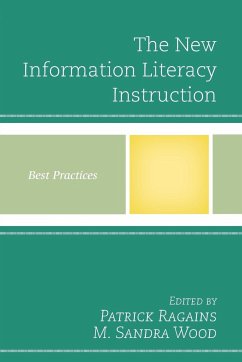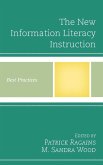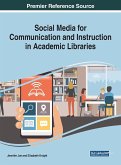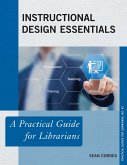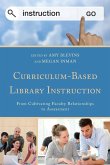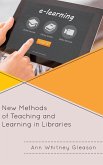- Broschiertes Buch
- Merkliste
- Auf die Merkliste
- Bewerten Bewerten
- Teilen
- Produkt teilen
- Produkterinnerung
- Produkterinnerung
The new ACRL information literacy concepts brings renewed interest in information literacy instruction and skills for librarians. The New Information Literacy Instruction: Best Practices offers guidance in planning for and implementing information literacy instruction programs in a wide range of instructional situations. As librarians take a new look at information literacy instruction, this essential book will help guide you in creating and maintaining a quality instruction program.
Andere Kunden interessierten sich auch für
![New Information Literacy Instruction New Information Literacy Instruction]() Patrick RagainsNew Information Literacy Instruction120,99 €
Patrick RagainsNew Information Literacy Instruction120,99 €![Social Media for Communication and Instruction in Academic Libraries Social Media for Communication and Instruction in Academic Libraries]() Social Media for Communication and Instruction in Academic Libraries179,99 €
Social Media for Communication and Instruction in Academic Libraries179,99 €![Curriculum-Based Library Instruction Curriculum-Based Library Instruction]() Curriculum-Based Library Instruction138,99 €
Curriculum-Based Library Instruction138,99 €![Instructional Design Essentials Instructional Design Essentials]() Sean CordesInstructional Design Essentials79,99 €
Sean CordesInstructional Design Essentials79,99 €![Curriculum-Based Library Instruction Curriculum-Based Library Instruction]() Curriculum-Based Library Instruction84,99 €
Curriculum-Based Library Instruction84,99 €![Maximizing the One-Shot Maximizing the One-Shot]() Jill MarkgrafMaximizing the One-Shot131,99 €
Jill MarkgrafMaximizing the One-Shot131,99 €![New Methods of Teaching and Learning in Libraries New Methods of Teaching and Learning in Libraries]() Ann Whitney GleasonNew Methods of Teaching and Learning in Libraries125,99 €
Ann Whitney GleasonNew Methods of Teaching and Learning in Libraries125,99 €-
-
-
The new ACRL information literacy concepts brings renewed interest in information literacy instruction and skills for librarians. The New Information Literacy Instruction: Best Practices offers guidance in planning for and implementing information literacy instruction programs in a wide range of instructional situations. As librarians take a new look at information literacy instruction, this essential book will help guide you in creating and maintaining a quality instruction program.
Produktdetails
- Produktdetails
- Verlag: Rowman & Littlefield Publishers
- Seitenzahl: 246
- Erscheinungstermin: 5. November 2015
- Englisch
- Abmessung: 229mm x 152mm x 15mm
- Gewicht: 405g
- ISBN-13: 9781442257931
- ISBN-10: 1442257938
- Artikelnr.: 43173898
- Herstellerkennzeichnung
- Libri GmbH
- Europaallee 1
- 36244 Bad Hersfeld
- gpsr@libri.de
- Verlag: Rowman & Littlefield Publishers
- Seitenzahl: 246
- Erscheinungstermin: 5. November 2015
- Englisch
- Abmessung: 229mm x 152mm x 15mm
- Gewicht: 405g
- ISBN-13: 9781442257931
- ISBN-10: 1442257938
- Artikelnr.: 43173898
- Herstellerkennzeichnung
- Libri GmbH
- Europaallee 1
- 36244 Bad Hersfeld
- gpsr@libri.de
Patrick Ragains is Business and Government Information Librarian at the University of Nevada, Reno. He holds an MLS from the University of Arizona (1987) and an MA in History from Northern Arizona University (1984). He has edited Information Literacy Instruction That Works: A Guide to Teaching by Discipline and Student Population (ALA/Neal-Schuman, 2013) and has published articles in American Libraries, Communications in Information Literacy, Journal of Government Information, portal: Libraries & the Academy, and Research Strategies. He is former chair of the ACRL Research Committee and is active in the ACRL Instruction Section. M. Sandra Wood, MLS, MBA, is Librarian Emerita, Penn State University Libraries, and a Fellow of the Medical Library Association. Ms. Wood is founding and current editor of Medical Reference Services Quarterly (in its 34th volume). She was a librarian for over thirty-five years at the George T. Harrell Library, Milton S. Hershey Medical Center, Pennsylvania State University, specializing in reference, education, and database services. Ms. Wood has written or edited more than 12 books, the latest two entitled Health Sciences Librarianship and Successful Library Fundraising: Best Practices (both with Rowman & Littlefield Publishers, 2014).
Preface
Acknowledgments
Part I: Supporting Specific Academic Programs
Chapter 1. Think Like A Researcher: Integrating the Research Process Into
the Introductory Composition Curriculum
Susan Mikkelsen and Elizabeth McMunn-Tetangco
Chapter 2. Pairing Course Assessment with Library Instruction Assessment of
Freshmen Composition: A Collaborative Project
Heidi Slater, Michelle Rachal, and Patrick Ragains
Chapter 3. Best Practices in Information Literacy Instruction in Health
Science Education: Case Study of Developing an Information Literacy Program
in a College of Medicine
Suzanne Shurtz and Laura Ferguson
Chapter 4. Developing, Teaching, and Revising a Credit-bearing Information
Literacy Course: Research in the Information Age
Patrick Ragains
Chapter 5. Building Bridges for Student Success
Cindy A. Gruwell
Part II: Innovative Models for Information Literacy Instruction
Chapter 6. Right on Time: Best Practice in One-Shot Instruction
Heidi Buchanan and Beth McDonough
Chapter 7. The Role of the Flipped Classroom in Information Literacy
Programs
Sara Arnold-Garza
Part III: Branching Out: Teaching Special Literacies
Chapter 8. Visual Literacy
Benjamin R. Harris
Chapter 9. Information and Scientific Literacy Support: Aligning
Instruction with Standards and Frames to Prepare Students for Research and
Lifelong Learning
Michele R. Tennant, Mary E. Edwards, Hannah F. Norton, and Sara Russell
Gonzalez
Chapter 10. Diving into Data: Developing Data Fluency for Librarians
Scott Martin and Jo Angela Oehrli
Chapter 11. Teaching Spatial Literacy: Location, Distance, and Scale
Eva Dodsworth and Larry Laliberté
Chapter 12. Best Practices for Teaching with Primary Sources: A Case Study
Ellen Swain
Chapter 13. Digitizing History: A New Course That Brings History to Wider
Audiences
Patrick Ragains
Index
About the Contributors
Acknowledgments
Part I: Supporting Specific Academic Programs
Chapter 1. Think Like A Researcher: Integrating the Research Process Into
the Introductory Composition Curriculum
Susan Mikkelsen and Elizabeth McMunn-Tetangco
Chapter 2. Pairing Course Assessment with Library Instruction Assessment of
Freshmen Composition: A Collaborative Project
Heidi Slater, Michelle Rachal, and Patrick Ragains
Chapter 3. Best Practices in Information Literacy Instruction in Health
Science Education: Case Study of Developing an Information Literacy Program
in a College of Medicine
Suzanne Shurtz and Laura Ferguson
Chapter 4. Developing, Teaching, and Revising a Credit-bearing Information
Literacy Course: Research in the Information Age
Patrick Ragains
Chapter 5. Building Bridges for Student Success
Cindy A. Gruwell
Part II: Innovative Models for Information Literacy Instruction
Chapter 6. Right on Time: Best Practice in One-Shot Instruction
Heidi Buchanan and Beth McDonough
Chapter 7. The Role of the Flipped Classroom in Information Literacy
Programs
Sara Arnold-Garza
Part III: Branching Out: Teaching Special Literacies
Chapter 8. Visual Literacy
Benjamin R. Harris
Chapter 9. Information and Scientific Literacy Support: Aligning
Instruction with Standards and Frames to Prepare Students for Research and
Lifelong Learning
Michele R. Tennant, Mary E. Edwards, Hannah F. Norton, and Sara Russell
Gonzalez
Chapter 10. Diving into Data: Developing Data Fluency for Librarians
Scott Martin and Jo Angela Oehrli
Chapter 11. Teaching Spatial Literacy: Location, Distance, and Scale
Eva Dodsworth and Larry Laliberté
Chapter 12. Best Practices for Teaching with Primary Sources: A Case Study
Ellen Swain
Chapter 13. Digitizing History: A New Course That Brings History to Wider
Audiences
Patrick Ragains
Index
About the Contributors
Preface
Acknowledgments
Part I: Supporting Specific Academic Programs
Chapter 1. Think Like A Researcher: Integrating the Research Process Into
the Introductory Composition Curriculum
Susan Mikkelsen and Elizabeth McMunn-Tetangco
Chapter 2. Pairing Course Assessment with Library Instruction Assessment of
Freshmen Composition: A Collaborative Project
Heidi Slater, Michelle Rachal, and Patrick Ragains
Chapter 3. Best Practices in Information Literacy Instruction in Health
Science Education: Case Study of Developing an Information Literacy Program
in a College of Medicine
Suzanne Shurtz and Laura Ferguson
Chapter 4. Developing, Teaching, and Revising a Credit-bearing Information
Literacy Course: Research in the Information Age
Patrick Ragains
Chapter 5. Building Bridges for Student Success
Cindy A. Gruwell
Part II: Innovative Models for Information Literacy Instruction
Chapter 6. Right on Time: Best Practice in One-Shot Instruction
Heidi Buchanan and Beth McDonough
Chapter 7. The Role of the Flipped Classroom in Information Literacy
Programs
Sara Arnold-Garza
Part III: Branching Out: Teaching Special Literacies
Chapter 8. Visual Literacy
Benjamin R. Harris
Chapter 9. Information and Scientific Literacy Support: Aligning
Instruction with Standards and Frames to Prepare Students for Research and
Lifelong Learning
Michele R. Tennant, Mary E. Edwards, Hannah F. Norton, and Sara Russell
Gonzalez
Chapter 10. Diving into Data: Developing Data Fluency for Librarians
Scott Martin and Jo Angela Oehrli
Chapter 11. Teaching Spatial Literacy: Location, Distance, and Scale
Eva Dodsworth and Larry Laliberté
Chapter 12. Best Practices for Teaching with Primary Sources: A Case Study
Ellen Swain
Chapter 13. Digitizing History: A New Course That Brings History to Wider
Audiences
Patrick Ragains
Index
About the Contributors
Acknowledgments
Part I: Supporting Specific Academic Programs
Chapter 1. Think Like A Researcher: Integrating the Research Process Into
the Introductory Composition Curriculum
Susan Mikkelsen and Elizabeth McMunn-Tetangco
Chapter 2. Pairing Course Assessment with Library Instruction Assessment of
Freshmen Composition: A Collaborative Project
Heidi Slater, Michelle Rachal, and Patrick Ragains
Chapter 3. Best Practices in Information Literacy Instruction in Health
Science Education: Case Study of Developing an Information Literacy Program
in a College of Medicine
Suzanne Shurtz and Laura Ferguson
Chapter 4. Developing, Teaching, and Revising a Credit-bearing Information
Literacy Course: Research in the Information Age
Patrick Ragains
Chapter 5. Building Bridges for Student Success
Cindy A. Gruwell
Part II: Innovative Models for Information Literacy Instruction
Chapter 6. Right on Time: Best Practice in One-Shot Instruction
Heidi Buchanan and Beth McDonough
Chapter 7. The Role of the Flipped Classroom in Information Literacy
Programs
Sara Arnold-Garza
Part III: Branching Out: Teaching Special Literacies
Chapter 8. Visual Literacy
Benjamin R. Harris
Chapter 9. Information and Scientific Literacy Support: Aligning
Instruction with Standards and Frames to Prepare Students for Research and
Lifelong Learning
Michele R. Tennant, Mary E. Edwards, Hannah F. Norton, and Sara Russell
Gonzalez
Chapter 10. Diving into Data: Developing Data Fluency for Librarians
Scott Martin and Jo Angela Oehrli
Chapter 11. Teaching Spatial Literacy: Location, Distance, and Scale
Eva Dodsworth and Larry Laliberté
Chapter 12. Best Practices for Teaching with Primary Sources: A Case Study
Ellen Swain
Chapter 13. Digitizing History: A New Course That Brings History to Wider
Audiences
Patrick Ragains
Index
About the Contributors

